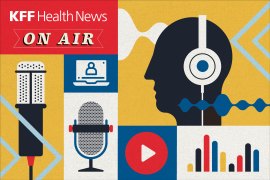Viewpoints: Unaffordable GLP-1s Push Patients Into A Risky Gray Market; TrumpRx Is Pricey Political Theater
Opinion writers tackle these public health issues.
Stat:
I’m Stuck In The Gray Market For GLP-1s
On Oct. 16, President Trump promised to slash the price of brand-name GLP-1 drugs like Ozempic and Wegovy to $150 a month. Even after a top health official suggested price negotiations between drugmakers and the administration were ongoing, the announcement sent Novo Nordisk and Eli Lilly stocks tumbling. For patients who’ve been priced out, that number sounded like relief. (Nick Dothee, 10/24)
Stat:
TrumpRx And A Most Favored Nation Policy Won’t Lower Prices For Patients
Recently, President Trump signed a “most-favored nation” executive order on drug prices with a claim that it would force pharmaceutical companies to lower U.S. prescription costs to match those abroad. As a result, the White House announced a deal with Pfizer to lower drug prices and a new direct-to-consumer website dubbed “TrumpRx.” (Tahir Amin, 10/24)
The Washington Post:
Can You Pick A Good Health Plan This Open Enrollment When It’s All Pricey?
My 27-year-old son, who works part-time, just received notice of his health insurance premium for next year. Under his Affordable Care Act plan through the Maryland marketplace, his monthly premium will increase by 17.1 percent. He’s also facing a 10.3 percent jump to his deductible, to just over $10,000, in 2026. (Michelle Singletary, 10/24)
The Washington Post:
How To Engage With AI Chatbots To Answer Medical Questions
Many readers shared how AI helped them make sense of their diagnoses and treatment options. Sharon from Rhode Island wrote that when her 2-year-old daughter was diagnosed with a rare brain cancer, she was terrified. The wait to see a specialist felt endless, so she turned to ChatGPT every day with the questions that she wanted to ask a doctor. (Leana S. Wen, 10/23)
Chicago Tribune:
Stop Letting Chicago’s Hospital Aid Flow To Wealthy Suburbs
Many of my constituents live in communities where hospitals have closed, clinics are underfunded and patients are forced to travel miles just to see a doctor. That’s exactly why Congress created the federal 340B Drug Pricing Program in 1992. The idea was to give hospitals that serve large numbers of low-income patients drugs at significant discounts, often 25% to 50% below market price, while still getting each drugs’ full reimbursement rate from insurance. They were supposed to invest the difference in price into free clinics, charity care and community health programs in the underserved areas they serve. (La Shawn K. Ford, 10/24)






